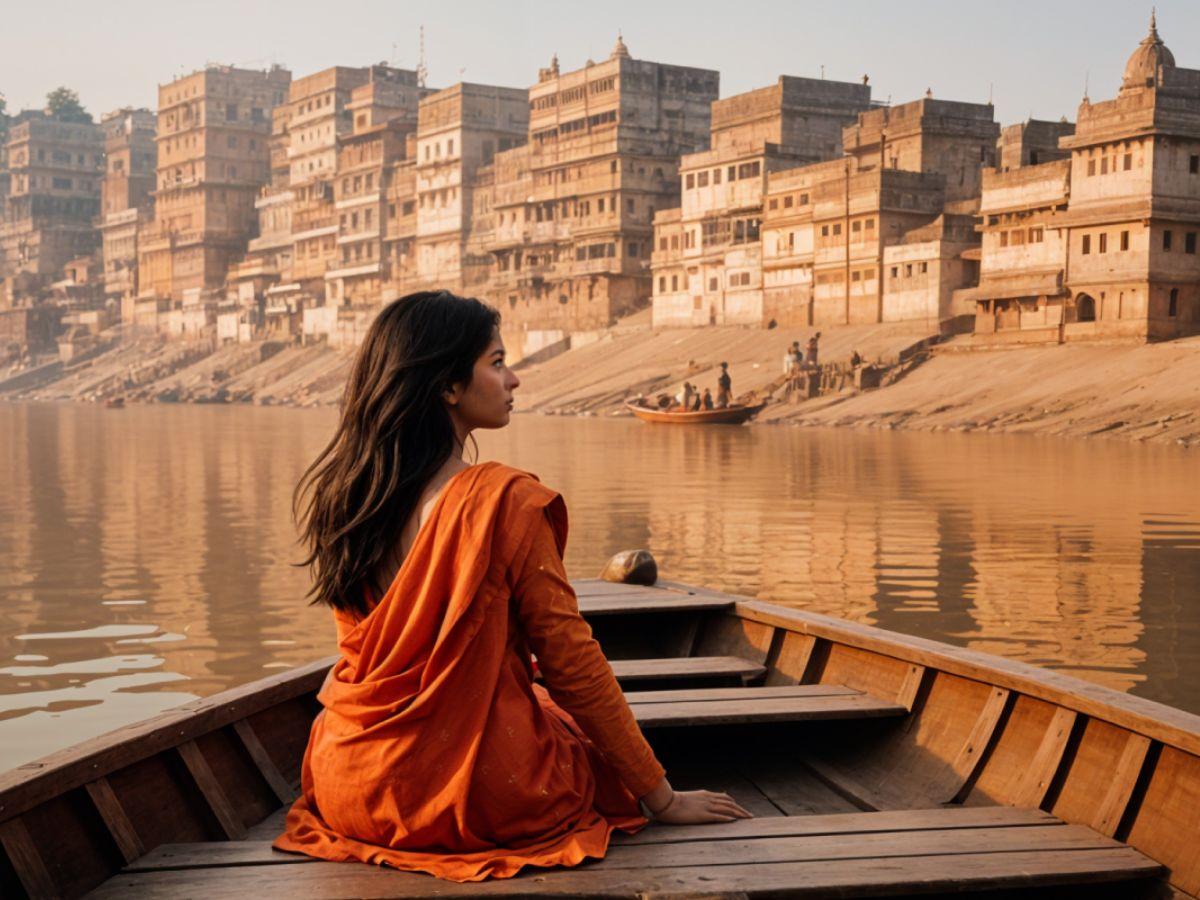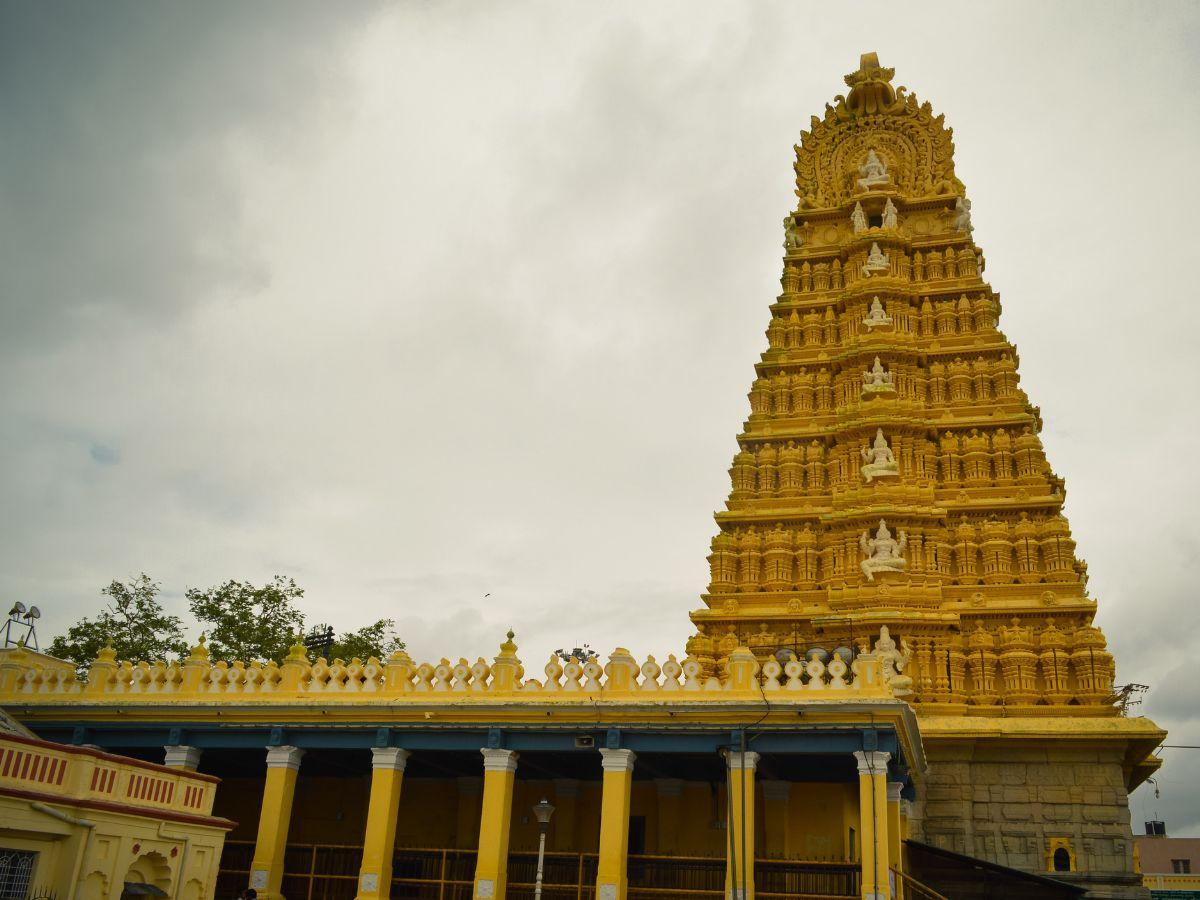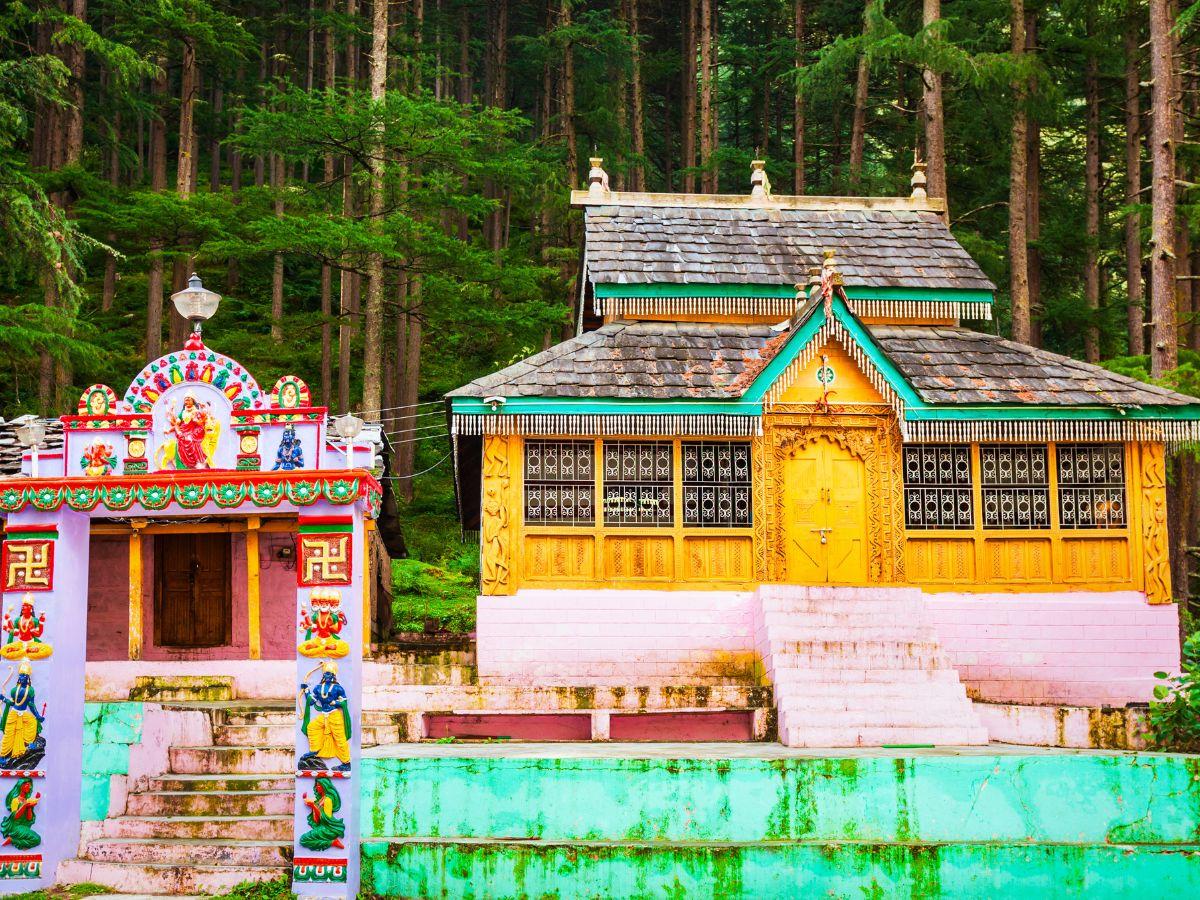Shivratri - a journey through traditions, culture & festivities
From the grand processions of Varanasi to the vibrant fairs of Mandi, explore the diverse and mesmerising ways India celebrates the divine union of Lord Shiva and Goddess Parvati on Maha Shivratri.

By Vamika Mudaliar
23 Feb, 2025
Maha Shivratri, meaning "The Great Night of Shiva," is one of the most revered Hindu festivals dedicated to Lord Shiva in India. Celebrated on the 14th day of the Hindu month of Phalguna, it marks the divine union of Shiva and Parvati. It is also believed to be the night when Lord Shiva performed Tandava, his cosmic dance.
While the core rituals of night-long prayers, fasting, and temple visits remain consistent, each region in India and Nepal has distinct traditions that make their celebration unique.
If you want to be a part of Maha Shivratri, below is a list of 11 spots where you can celebrate the event.
Devotees offering prayers at Mahabhairav shiva temple
1. Varanasi, Uttar Pradesh – the grand Shivratri procession and Ganga aarti
The Kashi Vishwanath temple, one of the most sacred Jyotirlingas, is located in Varanasi, the spiritual capital of India. It is believed that Shiva himself resides in this city, making Maha Shivratri celebration here a godly affair.
How it’s celebrated:
- The day begins with a holy dip in the Ganges followed by a visit to Kashi Vishwanath temple. Thousands of devotees take the sacred dip at sunrise, creating a divine atmosphere.
- The Shiva baraat (wedding procession of Lord Shiva) features people dressed as Shiva, Parvati, and Shiva’s celestial crew, dancing through the streets in a grand spectacle.
- The Ganga aarti at Dashashwamedh Ghat at night is a mesmerising sight, with synchronised lamps, ringing bells, and chants.
What to eat: Devotees enjoy Banarasi Thandai, made with milk, dry fruits, and bhang (optional), Malaiyo.
A woman, pilgrim, taking bath at Ganga
2. Kedarnath, Uttarakhand – a sacred pilgrimage in the Himalayas
Kedarnath holds deep historical significance, dating back to the Mahabharata era, when the Pandavas built the temple to seek Lord Shiva’s forgiveness. Shiva, disguised as a bull, disappeared into the ground, leaving his hump at Kedarnath, while other body parts surfaced at the Panch Kedar temples. Later, in the 8th century, Adi Shankaracharya reconstructed the temple and attained samadhi near the shrine, where his memorial stands today.
How it’s celebrated:
- Since Kedarnath Temple remains closed in winter, Maha Shivratri is celebrated at Omkareshwar Temple, where Lord Kedarnath’s idol is worshipped. A special rudrabhishek puja is held where milk, honey, and bael (wood apple) leaves are offered to the Shivalinga.
- Devotees observe nirjala (waterless) or fruit-based fasting, staying awake all night with bhajans, kirtans, and ‘Om Namah Shivaya’ chants to seek Lord Shiva’s blessings.
- A Shiva Shobha Yatra takes place in nearby towns and villages. Some devotees take a holy dip in the freezing Mandakini river, believing it purifies the soul.
- Temples host recitations of Shiva Purana, narrating the mythology of Maha Shivratri and Lord Shiva’s divine wedding with Parvati.
- The Omkareshwar Temple is beautifully lit with flowers and lamps, and cultural performances like Shiva Tandav dance add to the divine atmosphere. It's advisable to verify the current year's temple schedule before planning a visit.
What to eat: Fasting foods like dry fruits, milk-based sweets, and jaggery preparations are common.
Omkareshwar temple
3. Ujjain, Madhya Pradesh – the sacred Bhasma Aarti at Mahakaleshwar
Ujjain's Maha Shivratri holds immense historical and spiritual significance as it is home to the Mahakaleshwar Jyotirlinga, one of the twelve Jyotirlingas of Lord Shiva. The city has been a major Shaivite centre since ancient times, with mentions in Puranas and epics like the Mahabharata. Historically, Ujjain was the capital of the legendary King Vikramaditya and a key hub of astrology and learning. The festival is marked by grand Bhasma aarti at Mahakaleshwar temple, where sacred ash is offered to the deity, symbolising Shiva’s role as the lord of time and death. The city also hosts massive processions, night-long prayers, and cultural performances, making it one of the most significant Maha Shivratri celebrations in India.
How it’s celebrated:
- Bhasma Aarti is performed, the most iconic ritual, where sacred ash (Bhasma) is offered to Lord Shiva during an early morning aarti, symbolising the cycle of life and death. The aarti is performed early in the morning, around 4 AM. Devotees often need to register in advance to attend this ceremony.
- Devotees engage in Jagran (night vigil) with bhajans, kirtans, and Shiva chants, staying awake all night to seek blessings.
- A massive Shiva Shobha Yatra with beautifully decorated idols of Lord Shiva parades through the streets, accompanied by music and dance.
- Devotees take a ritual bath in the Shipra river, believed to cleanse sins and bring spiritual merit on this auspicious night.
- The Mahakaleshwar Temple and other Shiva shrines are adorned with flowers and lights, as devotees offer milk, bilva leaves, honey, and fruits to the deity.
What to eat: Devotees break their fast with Sabudana Khichdi, Singhare ka Halwa, and Kuttu Puri.
Bhasma aarti at Mahakaleshwar
4. Omkareshwar, Madhya Pradesh – devotion on an island temple
The Omkareshwar Temple is also one of the twelve Jyotirlingas of Lord Shiva. Located on the sacred Mandhata Island in the Narmada River, the temple is mentioned in ancient Hindu scriptures like the Puranas. According to legend, King Mandhata of the Ikshvaku dynasty meditated here to please Lord Shiva, who manifested as a Jyotirlinga. Another legend states that Adi Shankaracharya met his guru Govind Bhagavatpada at Omkareshwar, marking a key moment in his spiritual journey. The temple’s Nagara-style architecture and centuries-old inscriptions reflect its historical and cultural importance.
How it’s celebrated:
- Devotees offer milk, honey, bael leaves, and water to the jyotirlinga, followed by maha aarti at the temple, creating a deeply spiritual atmosphere.
- Pilgrims take a sacred bath in the Narmada River, believing it purifies sins and brings divine blessings.
- Devotees engage in Jagran (night vigil), singing Shiva bhajans and chanting ‘Om Namah Shivaya’ throughout the night.
- A grand procession of Lord Shiva’s idol moves through the town, accompanied by music, dance, and traditional performances.
- The Omkareshwar temple is beautifully decorated with flowers and lights, while the town hosts fairs, cultural programmes, and stalls selling prasad and religious items.
What to eat: Devotees break their fast with Rajgira Halwa and fruit-based offerings.
Hindu Sadhus singing bhajan on the eve of Maha Shivaratri
5. Somnath, Gujarat – the eternal shrine of lord Shiva
The Somnath Temple in Gujarat holds immense historical and spiritual significance as the first of the twelve Jyotirlingas of Lord Shiva. It is believed to have been originally built by Chandra Dev (the Moon God) to seek Lord Shiva’s blessings after being cursed by Daksha. The temple finds mentions in ancient texts like the Rigveda, Mahabharata, and Skanda Purana. Over centuries, Somnath was destroyed and rebuilt multiple times, notably plundered by Mahmud of Ghazni in 1025 AD, followed by attacks from Alauddin Khilji and Aurangzeb. The current structure was reconstructed in 1951 under the leadership of Sardar Vallabhbhai Patel, symbolising India's cultural and spiritual resilience.
How it’s celebrated:
- A special Rudrabhishek puja is performed with milk, honey, ghee, and bael leaves, followed by a grand Maha Aarti in the temple.
- Devotees sing Shiva bhajans, kirtans, and chant ‘Om Namah Shivaya’ throughout the night, staying awake in devotion.
- Pilgrims take a sacred dip at the Triveni Sangam, where the rivers Hiran, Kapila, and Saraswati meet, believing it purifies the soul.
- A grand procession of Lord Shiva’s idol moves through the town, accompanied by music, traditional dance, and decorated chariots.
- The Somnath Temple is adorned with lights, flowers, and diyas, creating a mesmerising spiritual atmosphere. Special fairs and stalls offer prasad and religious souvenirs.
What to eat: Gujarati fasting delicacies include Sabudana Khichdi and Shrikhand.
Somnath temple, Gujurat
6. Nageshwar, Gujarat – the protector from poisons
The Nageshwar Temple near Dwarka, in Gujarat holds great historical and spiritual significance as it is believed to be one of the twelve Jyotirlingas of Lord Shiva. The temple is mentioned in ancient scriptures like the Shiv Purana, which narrates the legend of a demon named Daruka, who imprisoned Shiva’s devotee Supriya. Lord Shiva appeared and defeated the demon, blessing the site as a sacred space for devotees. The temple is also associated with Dwarka and Lord Krishna, who is believed to have worshipped Lord Shiva here. With its towering Shiva statue and ancient architecture, Nageshwar remains a revered pilgrimage destination.
How it’s celebrated:
- A special Rudrabhishek puja is performed with milk, honey, ghee, and bael leaves, followed by a grand Maha Aarti at the Jyotirlinga.
- Devotees engage in Jagran (night vigil), singing bhajans and chanting ‘Om Namah Shivaya’ throughout the night.
- Many pilgrims take a ritual bath in the Gomti River, believing it purifies the soul and brings blessings from Lord Shiva.
- A grand Shiva Shobha Yatra with beautifully decorated chariots and idols of Lord Shiva moves through the town with music and dance.
- The Nageshwar Temple is adorned with flowers and lights, attracting thousands of devotees who offer prayers, visit local fairs, and seek Lord Shiva’s blessings.
What to eat: Devotees consume makhana kheer and vrat-friendly rotis.
Shiva Idol near Nageshwar temple, Gujurat
7. Baidyanath, Jharkhand – the healing shrine of Shiva
The Baidyanath Temple also known as Vaidyanath or Baba Baidyanath Dham. Located in Deoghar, Jharkhand, is also one of the twelve Jyotirlingas of Lord Shiva and holds immense historical and mythological significance. According to legend, Ravana, the demon king of Lanka, was a great devotee of Shiva and performed intense penance to bring Shiva to Lanka. Pleased by his devotion, Shiva granted him a Jyotirlinga, but on the condition that it should not be placed on the ground. However, Ravana was tricked by Lord Vishnu in disguise, causing him to drop the lingam at Deoghar, making it a sacred site. The temple is also linked to Ayurveda, as Shiva is believed to have appeared as a vaidya (doctor) to heal Ravana, giving it the name Baidyanath.
How it’s celebrated:
- Devotees offer milk, water, honey, bael leaves, ghee, and dhatura to the Jyotirlinga, performing the sacred Rudrabhishek ritual.
- Devotees observe Jagran (night vigil), singing Shiva bhajans and chanting ‘Har Har Mahadev’ throughout the night.
- Pilgrims, especially Kanwariyas, walk barefoot carrying holy Ganga water from Sultanganj to offer it to Lord Shiva at the temple.
- A Shiva Shobha Yatra with a beautifully decorated idol of Lord Shiva is carried through the streets with music and dance.
- The Baidyanath Temple is adorned with flowers and lights, while fairs, stalls, and cultural events add to the festive spirit.
What to eat: Devotees enjoy local offerings of fruits and dry fruits.
A priest is offering greetings to Lord Shiva at Baidyanath
8. Trimbakeshwar, Nashik – the origin of the Godavari
The Trimbakeshwar Temple in Nashik, Maharashtra, holds immense historical and spiritual significance as one of the twelve Jyotirlingas of Lord Shiva. It is uniquely revered because the linga here has three faces, symbolising Brahma, Vishnu, and Mahesh (Shiva). According to Hindu mythology, the sacred Godavari River originated here due to the penance of sage Gautama, making it a highly significant pilgrimage site. The temple is also associated with the Kumbh Mela, one of the largest religious gatherings, held in Nashik every twelve years. Built in the 18th century by the Peshwa ruler Nana Saheb, the temple is an architectural marvel with intricate stone carvings, reflecting its deep historical and cultural importance.
How it’s celebrated:
- Devotees take a ritual bath in the sacred Kushavarta Kund, believed to wash away sins before offering prayers to Lord Shiva.
- The Jyotirlinga, which represents Brahma, Vishnu, and Shiva, is worshipped with milk, honey, bael leaves, and ghee, followed by a grand Maha Aarti.
- Devotees engage in Jagran (night vigil), singing Shiva bhajans, kirtans, and chanting ‘Om Namah Shivaya’ throughout the night.
- A grand procession with Shiva idols, chariots, and devotees dressed as mythological characters moves through the streets of Trimbak.
- The Trimbakeshwar Temple is illuminated with lights and flowers, while fairs, cultural programmes, and stalls selling prasad and spiritual items add to the celebration.
What to eat: Traditional Panchamrit prasad is distributed.
Trimbakeshwar temple
9. Bhimashankar, Maharashtra – the seat of Shiva’s power
The Bhimashankar Temple in Maharashtra is one of the twelve Jyotirlingas of Lord Shiva and holds great historical and mythological significance. According to legend, the temple is linked to the demon Bhimasura, the son of Kumbhakarna (Ravana’s brother). Bhimasura performed intense penance to gain power, but when he misused it to terrorise sages, Lord Shiva appeared and defeated him, establishing himself as the Bhimashankar Jyotirlinga. The temple’s architecture reflects Nagara-style influences, believed to have been constructed in the 13th century, with later contributions by Nana Phadnavis in the 18th century. Nestled in the Sahyadri Hills, the temple is also significant for being the source of the Bhima River and is surrounded by a wildlife sanctuary, adding to its spiritual and natural beauty.
How it’s celebrated:
- The Jyotirlinga is bathed in milk, honey, ghee, and bael leaves, followed by a grand Maha Aarti, drawing thousands of devotees.
- Devotees observe Jagran (night vigil), singing Shiva bhajans and chanting ‘Om Namah Shivaya’ throughout the night.
- Many pilgrims undertake a trek through the Sahyadri hills to reach the temple, symbolising devotion and penance.
- A grand Shiva procession (Shobha Yatra) with decorated chariots, traditional music, and dance moves through the temple town.
- The Bhimashankar Temple is illuminated with lights and flowers, while fairs, stalls, and cultural programmes create a vibrant spiritual environment.
What to eat: Peanut ladoos and coconut-based sweets are popular.
Inside Bhimshankar temple, Maharastra
10. Mallikarjuna, Andhra Pradesh – the southern Kailash
The Mallikarjuna Temple in Srisailam, Andhra Pradesh, is one of the twelve Jyotirlingas of Lord Shiva and also a Shakti Peetha, making it a highly revered pilgrimage site. According to legend, Lord Shiva and Goddess Parvati came to Srisailam to console their son, Kartikeya, who was upset over his brother Ganesha’s marriage. Pleased with the devotion of the locals, Shiva manifested as Mallikarjuna (a form of Shiva) and Parvati as Brahmaramba, establishing the temple. The site has been a sacred centre for centuries, with references in ancient scriptures like the Skanda Purana and Shiva Purana. The temple was patronised by several rulers, including the Satavahanas, Vijayanagara kings, and Kakatiya dynasty, reflecting its deep historical and architectural significance.
How it’s celebrated:
- The Mallikarjuna Jyotirlinga is worshipped with milk, honey, bael leaves, and ghee, followed by a grand Maha Aarti in the temple.
- Devotees observe Jagran (night vigil), singing Shiva bhajans and chanting ‘Om Namah Shivaya’ throughout the night.
- A special midnight ritual is performed, symbolising Lord Shiva’s cosmic emergence in the form of a Jyotirlinga.
- A grand Shiva Shobha Yatra with decorated chariots, idols, and traditional performances moves through the temple town.
- The temple is illuminated with one lakh oil lamps (Laksha Deepotsavam), creating a divine atmosphere. Cultural programmes and spiritual discourses also take place.
What to eat: Devotees enjoy rice-based prasad like Pulihora and Pongal.
Mallikarjuna, Andhra Pradesh
11. Rameshwaram, Tamil Nadu – the sacred Jyotirlinga by the sea
The Ramanathaswamy Temple in Rameshwaram, Tamil Nadu, holds immense historical and mythological significance as one of the twelve Jyotirlingas of Lord Shiva and a sacred Char Dham pilgrimage site. According to the Ramayana, Lord Rama and his army stopped at Rameshwaram before crossing to Lanka to rescue Sita from Ravana. To seek Lord Shiva’s blessings and atone for any sins committed during battle, Rama established a Shivalinga, which is now worshipped as Ramanathaswamy. The temple, with its magnificent Dravidian architecture, was expanded by the Pandya and Nayaka kings in the 12th century. It is also known for its longest temple corridor in the world and the 22 holy theerthams (water tanks), where pilgrims take ritual baths for spiritual purification.
How it’s celebrated:
- The Ramanathaswamy Jyotirlinga is bathed in holy water, milk, honey, ghee, and bael leaves, followed by an elaborate Maha Aarti.
- Devotees take a ritual dip in the 22 sacred theerthams inside the temple premises before offering prayers.
- Night-long Jagran (vigil) is observed, where devotees chant Shiva mantras and sing bhajans in praise of Lord Shiva.
- A grand procession of Lord Shiva’s idol is carried through the temple and surrounding streets, accompanied by traditional music and dance.
- The temple is decorated with lamps and flowers, and spiritual discourses, cultural performances, and devotional gatherings take place.
What to eat: Offerings of tamarind rice, payasam, and coconut-based dishes are common.
Rameshwaram temple, Tamil Nadu
Conclusion
Maha Shivratri is not just a festival, it’s an experience of devotion, meditation, and self-purification. From the grand Bhasma Aarti in Ujjain to the cultural fairs in Mandi and the holy Ganga Aarti in Varanasi, each place offers a unique yet deeply spiritual way to celebrate the divine night of Shiva.
If you're looking for an affordable yet comfortable stay near any of these destinations, The Hosteller provides a perfect option for budget-conscious travellers. With its vibrant atmosphere and comfortable stays, you can immerse yourself in the festival without breaking the bank.
Where would you like to celebrate Maha Shivratri this year?
thehosteller
Destinations
Destinations







